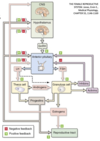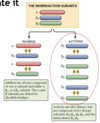Menstrual Cycle and Ovulation (Creamer) Flashcards
Schematic of the menstrual cycle hormonal changes:

Describe ovulation in terms of stages of meiosis:
- meiotic arrest (prophase I): elevated levels of cAMP; large antral follicles gain meiotic competence (stay is arrest until LH surge, can stay in this stage ~50 years)
- meiosis I finishes before ovulation: polar body 1 extruded
- meiotic arrest (metaphase II): elevated levels MAPK proteins
- resumption of meiosis II only at fertilization: rapid degradation of MAPK, polar body 2 extruded

What are the 3 phases of the ovarian cycle?
- follicular phase
- ovulatory phase
- luteal phase
- functional until of the ovary
- performs gametogenic and endocrine functions
- pre-menopausal cycling ovary contains follicular structures at many different stages
ovarian follicle

Describe the follicular phase of the ovarian cycle:
- the follicle selected for that particular month begins to grow
- follicular phase starts with the first day of your period and ends with ovulation
- each follicle houses a primary oocyte arrested in prophase I
- most developed Graafian follicle releases its oocyte during ovulation
- as that primary oocyte is released, it finishes its first meiotic division, becoming a secondary oocyte (arrested in metaphase II)

What are the steps of the follicular phase?
1) resting primordial follicle
2) growing preantral (primary and secondary) follicle
3) growing antral (tertiary) follicle
4) dominant (preovulatory, graafian) follicle
5) dominant follicle within periovulatory period
6) corpus luteum (of menstruation or of pregnancy)
7) atretic follicles

- primary oocyte arrested in prophase I (can remain for 50 years)
- surrounded by a single layer of pregranulosa cells
- release paracrine factors, no seroid hormones
- represents the ovarian reserve, of which most will undergo atresia (400-500 develop and ovulate)
primordial follicle

- central primary oocyte
- single layer of granulosa cells take on cuboidal shape
- increase in size of follicle due to growth of primary oocyte
- early production of secreted glycoproteins: ZP1, ZP2, ZP3, ZP4
primary follicle

- primary oocyte surrounded by 3-6 layers of cuboidal granulosa cells
- secretion of paracrine factors to induce local stromal cells to differentiate into thecal cells: inner glandular highly vascular theca interna, fibrous capsule-like theca externa
secondary follicle

How does progression into secondary follicle occur?
- involves increased vascularization
- migration from outer cortex to inner cortex, closer to ovarian vasculature
- follicles release angiogenic factors that induce development of 1-2 arterioles: generates vascular wreath around follicle
- zona pellucida development occurs: provides binding sites for sperm during fertilization
What type of hormonal signaling occurs during growth of preantral follicles?
- minimal endocrine function
- granulosa cells express FSH receptors, primarily dependent on paracrine factors from oocyte for growth
- granulosa cells do not produce ovarian hormones at this point
- thecal cells are analagous to testicular Leydig cells: express LH receptors, major product is androstenedione (although at this point production is minimal/absent)
Describe the antral phase of the follicular phase of the ovarian cycle of the menstrual cycle:
:)
- appearance of the antrum marks beginning of antral phase
- oocyte becomes suspended in fluid surrounded by a dense mass of granulosa cells (cumulus oophorus)
- two populations of granulosa cells develop: mural granulosa (stratum granulosum) and cumulus cells (cumulus oophorus/corona radiate)
- follicle growth becomes responsive to androgens during this phase
- oocytes grow rapidly during this stage, which slows in larger follicles
- oocyte becomes competent to complete meiosis I at ovulation: oocyte synthesizes sufficient amnts of cell cycle components (e.g. cyclin-dependent kinase 1, cyclin B); larger follicles gain meiotic competence but still maintain meiotic arrest until midcycle LH surge; meiotic arrest is maintained by elevated cAMP levels in mature oocyte)
- increase in follicular size depends on: increase in antral size, volume of follicular fluid, proliferation of granulosa cells

What are the 2 distinct granulosa cell populations that develop during the antral phase of follicular development?
(100-fold increase in granulosa cells occurs)
- mural granulosa (stratum granulosum): outer wall of follicle, become highly steroidogenic
- cumulus cells (cumulus oophorus/corona radiata): maintain gap and adhesion junctions w/ oocyte; released during ovulation w/ oocyte
When does follicle growth become responsive to gonadotropins?
- during the antral follicle growth phase
- theca interna - LH: synthesize androgens from acetate and cholesterol; androstenedione is major steroid product; limited estrogen synthesis
- granulosa - FSH: convert androgens from thecal cells (granulosa-mediated aromatization of androgens to estrogens, stimulated by FSH); induces expression of LH receptors late in follicular phase

How does FSH play a role in selection for follicle for ovulation?
- several large antral follicles are recruited to begin development each monthly cycle
- selection of 1 dominant follicle occurs early in follicular phase
- mural granulosa produce low levels of estrogen and inhibin B
- FSH levels decline: largest follicle w/ most FSH receptors (highest sensitivity) becomes dominant follicle; other follicles undergo atresia (apoptosis of oocytes and granulosa cells)
- midcyle, dominant follicle becomes a large preovulatory follicle (Graffian follicle)

Describe the periovulatory period:
- time from onset of LH surge to ovulation: 32-36 hours
- structural changes occur to prepare for ovulation
- changes in steroidogenic function of theca and mural granulosa occur: prepares for luteinization, formation of corpus luteum, increased production of progesterone

What changes occur with the LH surge in terms of granulosa cells?
- LH surge induces differentiation (luteinization) of granulosa to granulosa lutein cells
- thecal and mural granulosa cells express LH receptors at surge which induces a shift in steroidogenic activity
- transient inhibition of aromatase expression: rapid decline reduces positive feedback on LH secretion
- increased vascularization of granulosa occurs: increases cholesterol availability for progesterone production

What structural changes occur w/ LH surge?
- release of cytokines and hydrolytic enzymes from theca and granulosa: breakdown of follicle wall, tunica albuginea, surface epithelium
- cumulus-oocyte complex detaches (free floating in antrum)
- basal lamina of mural granulosa degraded: angiogenic factors released, increased blood supply to follicle/corpus luteum
- LH surge induces oocyte to progress to metaphase II
What occurs during the luteal phase of ovarian cycle?
- LH surge causes granulosa differentiation and structural changes (increases vascularization), and induces oocyte to progess to metaphase II
- antral cavity fills w/ blood/cell debris: corpus hemorrhagicum, removed by macrophages
- granulosa lutein cells collapse into antral cavity: filled w/ cholesterol esters; theca, blood vessels, white blood cells fill remainder of cavity; often yellow in color due to carotenoid pigment (lutein)
Describe the corpus luteum of menstruation:
- remains ~14 days
- becomes corpus albicans: scar-like body, primarily collagen
- if rescued by hCG from conceptus, will remain viable for duration of pregnancy (similar in structure to LH)
Describe the corpus luteum of pregnancy:
- CL produces increasing progesterone: transforms uterine lining into adhesive and supportive structure, important for implantation and early pregnancy
- transient decrease in estrogen following LH surge, rebounds and peaks midluteal phase
- progesterone and estrogen reduce LH to basal levels: hCG compensates for this decline
- lutein cells secrete inhibin A, suppresses FSH
- demise of an ovarian follicle
- predominant process in the ovary
- can occur at any time during development
- during this process, granulosa cells and oocytes undergo apoptosis
- thecal cells persist and repopulate cellular stroma of the ovary: retain LH receptors and ability to produce androgens, collectively are referred to as interstitial gland of the ovary
follicular atresia
Describe the hypothalamic-pituitary-ovarian axis:
- hypothalamic neurons synthesize/store/release GnRH
- GnRH binds to receptors on gonadotropins, resulting in synthesis/release of FSH/LH
- FSH and LH stimulate ovaries to synthesize/secrete estrogens and progestins
- ovaries (granulosa cells) also produce inhibin and activin peptides
- ovarian steroids and peptides exert both negative and positive feedback on both hypothalamus and anterior pituitary

How does pulsatile release of GnRH affect LH secretion?
- early in follicular phase, gonadotrophs are not very GnRH sensitive, each burst of GnRH only elicits a small rise in LH
- later in the follicular phase, gonadotrophs in anterior pituitary become much more sensitive to GnRH in portal blood, each burst of GnRH triggers a much larger release of LH














